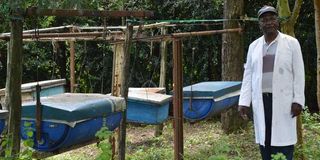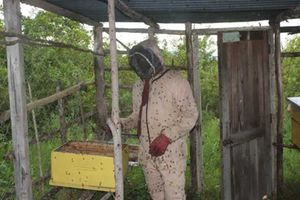
Henry Muchiri inspects some of the hives he made from plastic drums at his Ndanyat farm in Kajiado West Sub-County.
“African bees are not friendly. You have to deal with them at night. Even so, you must be in a bee-keeper’s suit – a specialised protective garment – so as not to be stung,” Henry Muchiri says.
As he ushers the Seeds of Gold team to his three-acre farm in Ndanyat, Kajiado County, he adds: “It is no ordinary suit. It must have a veil or hood to cover the head and face, a jacket with a zipper or buttons, and long pants or overalls to cover the entire body.”
“I will try to be as near to the bees as I can today. They are used to me but as visitors, you must exercise a lot of caution.”
The retired civil servant says there are many dangers one encounters when working with bees.
“I started bee-keeping in 2016. It was out of passion for I had no training in apiculture,” says the accountant who left public service in 1997.
“I met the person who came up with the popular Kenya Top Bar Hive (KTBH) and we became friends. He showed me how to keep bees in wooden hives.”
At first, monkeys raided his hives at night.
“I suffered losses so I thought the best thing to do was to make a different kind of hive. But I knew hives do not come cheap,” Muchiri says.
“As I was thinking about making a different hive, I saw plastic drums. I thought of modifying them to accommodate my bees.”

Henry Muchiri with one of the hives made from plastic drums at his farm in Kajiado.
One plastic drum makes two beehives.
“This is a great hive. It does not soak in water when it rains, unlike wooden ones. Its durability is guaranteed. It is a lifetime hive as long as you keep the wax moth at bay,” he says.
Muchiri’s plastic drum beehive has a queen chamber, two layers of plywood to filter heat, some 26 bars and a honey chamber.
He says bees do not like very hot places, meaning the temperatures need to be controlled.
The Kenya Forestry Research Institute says bee-keepers in Kenya use mainly the traditional log, Kenya Top Bar and the Langstroth hives. Muchiri’s is the latest in the market.
He advises farmers to change from wooden hives to plastic drums as these are easy to clean and maintain.
“With this hive, the health of the colony is guaranteed. It can produce more than 40 kilos of honey a year,” he says.
With a kilo going for Sh500 to Sh1,000, one can make Sh20,000 to Sh40,000 from a hive.”
Muchiri has eight plastic drum hives, which are all colonised. His bees have never migrated.
“This part of Kajiado County is prone to droughts. There are few flowers,” he says.
According to Muchiri, maintaining the plastic drum hives in a dry region requires skills. He has a reservoir where the insects get water.
“Like all organisms, bees need water. They drink water, feed the young with water and use water to regulate temperature in their hives and make honey,” he says.
One of his main challenges is the effects of climate change.
“I harvested honey two times a year when I began for there were many plants around. Today, the harvesting per hive is just once. There are years I don’t harvest at all,” he says.
What pests does he look out for? He says the sugar ant and wax moth larvae easily destroy the wax combs.
“They tunnel and chew through combs, especially the combs with brood and pollen. Healthy, populous honey bee colonies can be destroyed by wax moth larvae in days,” Muchiri says, adding that apiary hygiene is the secret to good harvests.
He applies grease on the suspension wires to control the sugar ants.
John Kioko, a natural resource management expert and programme coordinator for WWF-Kenya, says the organisation welcomes innovations that boost the production of honey.
“Eighty percent of Kajiado is dry. Innovations like Muchiri’s are welcome as they promote the use of non-timber forest products, tree planting, and improve crop and pollination,” he says.







